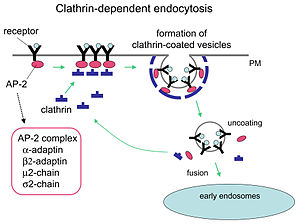- Receptor-mediated endocytosis
-
Receptor-mediated endocytosis (RME), also called clathrin-dependent endocytosis, is a process by which cells internalize molecules (endocytosis) by the inward budding of plasma membrane vesicles containing proteins with receptor sites specific to the molecules being internalized.
Contents
Process
After the binding of a ligand to plasma membrane-spanning receptors, a signal is sent through the membrane, leading to membrane coating, and formation of a membrane invagination. The receptor and its ligand are then opsonized in clathrin-coated vesicles. Once opsonized, the clathrin-coated vesicle uncoats (a pre-requisite for the vesicle to fuse with other membranes) and individual vesicles fuse to form the early endosome. Since the receptor is internalized with the ligand, the system is saturable and uptake will decline until receptors are recycled to the surface. Common for biology.
Function
The function of receptor-mediated endocytosis is diverse. It is widely used for the specific uptake of certain substances required by the cell (examples include LDL via the LDL receptor or iron via transferrin). The role of receptor-mediated endocytosis is also well recognized in the downregulation of transmembrane signal transduction. The activated receptor becomes internalised and is transported to late endosomes and lysosomes for degradation. However, receptor-mediated endocytosis is also actively implicated in transducing signals from the cell periphery to the nucleus. This became apparent when it was found that the association and formation of specific signaling complexes is required for the effective signaling of hormones (e.g. EGF). Additionally it has been proposed that the directed transport of active signaling complexes to the nucleus might be required to enable signaling as random diffusion is too slow[1] and mechanisms permanently downregulating incoming signals are strong enough to shutdown signaling completely without additional signals transducing mechanisms.[2]
Experiments
Using fluorescent dyes to stain the plasma membrane, it is possible to follow the internalization of plasma membrane fragments by microscopy.
Since the process is non-specific, the ligand can be a carrier for larger molecules. If the target cell has a known specific pinocytotic receptor drugs can be attached and will be internalized.
Specific Properties
- induction within minutes of exposure to excess ligand.
- the formation of these vesicles is sensitive to inhibition by wortmannin
- the initiation of vesicle formation can be delayed/inhibited by temperature variations
See also
References
- ^ Howe, Charles L. (2005). "Modeling the Signaling Endosome Hypothesis: Why a Drive to the Nucleus Is Better Than a (Random) Walk". Theor. Biol. Med. Mod 2 (1): 43. doi:10.1186/1742-4682-2-43. PMC 1276819. PMID 16236165. 2:43. http://www.pubmedcentral.nih.gov/articlerender.fcgi?tool=pmcentrez&artid=1276819.
- ^ Kholodenko, Boris N. (2003). "Four-Dimensional Organisation of Protein Kinase Signaling Cascades: the Roles of Diffusion, Endocytosis and Molecular Motors". J. Exp. Biol 206 (Pt 12): 2073. doi:10.1242/jeb.00298. PMID 12756289. 206, 2073-2082.
External links
- CytoChemistry.net- A lecture on RME with some nice pictures
Membranes: Membrane transport Passive transport Diffusion: Facilitated diffusion ([Uniporter])
OsmosisActive transport -cytosis Exocytosis (Degranulation) - Endocytosis (Phagocytosis, transcytosis, fluid-phase pinocytosis, non-specific, adsorptive pinocytosis, Receptor-mediated endocytosis, Potocytosis, Efferocytosis)Synaptic vesicle OtherCOPI COPII RME/Clathrin Caveolae Other/ungrouped Vesicle formationAdaptor protein complex 1: AP1AR · AP1B1 · AP1G1 · AP1G2 · AP1M1 · AP1M2 · AP1S1 · AP1S2 · AP1S3
Adaptor protein complex 2: AP2A1 · AP2A2 · AP2B1 · AP2M1 · AP2S1
Adaptor protein complex 3: AP3B1 · AP3B2 · AP3D1 · AP3M1 · AP3M2 · AP3S1 · AP3S2
Adaptor protein complex 4: AP4B1 · AP4E1 · AP4M1 · AP4S1
Coats: Retromer · TIP47OtherCategories:- Cellular processes
- Cell biology stubs
Wikimedia Foundation. 2010.

